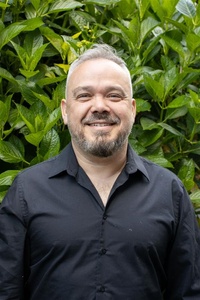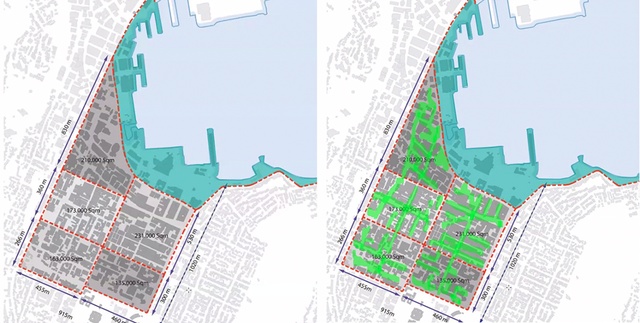The art of changing everything without changing anything
Iván Santamarina, founder of Urbanhub Aotearoa, reflects on the influence of leading urbanist Salvador Rueda and what change his ‘Superblock’ model could have locally after Rueda's recent visit to NZ.
Three weeks on from the visit of urbanist icons Salvador Rueda and Janette Sadik-Kahn to Aotearoa I still feel completely charged up. All that goodness, those powerful messages, and a will to change the status quo. Bring it on!
Emerging from my urbanist’s hangover I ask, “Okay what now?” How can I, a true urbanist, build on their powerful messages?

How can I contribute to my adopted homeland and promote what years of science and evidence are telling us? Most importantly, how can I help future generations prepare for what is coming? I need to be able to look my 20-year-old nephew in the eye and tell him I’ve done my best.
I made a start in 2021 by organising a live digital presentation with Salvador at the VUW School of Architecture. It roused some public interest and Salvador was invited to the 2Walk&Cycle conference. I tell myself, “Not bad, we’ve got a non-English speaker in the house. That’s a win!”
My first experience of Rueda was when he gave a lecture at my architecture school in Spain. As a future urbanist committed to cycling, I was becoming aware of the negative impact of cars in our cities.
Cycling in Spanish cities in the late nineties was fearsome, to the point I almost gave up. However, Rueda’s warning that unsustainable cities had been caused by placing the car in the centre of planning, got a hold on me.
I remember when, as a 15-year-old exchange student, I cried out “Where is everyone?” when driving through a small mid-west town by the Mississippi River. The obvious answer was, in their homes or inside their cars. This question still activates me 30 years later when I look at the New Zealand paradise of five million people and our potential to do things differently.
Early in his career, Rueda wanted to study and investigate the human brain (he has a combined degree in psychology and biology from the University of Barcelona). The human brain is the most complex system we know. It was the topic of life casualties that led him to study cities, the most complex ecosystem the human species have created while obtaining his master’s in energy and environmental engineering.
Rueda ran the Urban Ecology Authority of Barcelona, a city council agency that has led 400 urban ecology projects in 144 cities around the world. His team specifically addressed the built environment with a methodological approach that came from his academic studies in ecology called ecosystemic urbanism, where cities are treated as ecosystems. Now he leads the Urban Ecology Foundation and has drafted the charter of ecosystemic urbanism for the planning of cities. It puts people (not cars) at the centre of everything.
He is famous for being the father of the Superblock model. Under a noise and air pollution emergency, the Barcelona Urban Ecology Authority (BUEA) used data to quieten a city that was out of control with traffic noise and pollution.
Unwanted noise damages people’s lives and negatively conditions our psychology. When the noise level reaches over 65 dBA people must shout to be understood. The BUEA research discovered that all thoroughfares carrying heavy traffic were always over that mark.
To reduce this and maintain communication noise levels suitable for people, they needed to reduce traffic in the noisiest streets to 1,000 cars per day. This is when the idea of the Superblocks was born.
An added result of Superblocks is that they cooled and calmed the city, creating safe and accessible shared public space for people to use. The space was already there — it was just reclaimed and repurposed for the people.
Private vehicles are allowed to access all the blocks inside the superblock, however, a circuit system allows them to enter at single points at a maximum speed of 10 km/h. Basically you enter a shared space where cars must negotiate with other active modes of transportation, such as bicycles, that are allowed to move in both directions. That speed makes the use of public space compatible with pedestrian safety.
Once public space of the internal streets is redistributed, new uses are introduced inside the superblock. People use their streets for entertainment, leisure, playgrounds, markets, spaces for culture and art. Accessibility is total.
On his visit, I took Salvador to Te Motu Kairangi Miramar Peninsula for a good view of Te-Whanganui-a-Tara’s harbour, up to Tangi-te-keo Mount Victoria for a good understanding of Wellington’s physical reality, and finally we had a walk around Te Aro. After all that, I asked him, “What do you think, are Superblocks a go in Te Aro?”. His encouraging response: “Definitely”.

A Superblock Challenge for Te Aro Wellington
We had proposed Superblocks for Te Aro in our shared digital presentation back in 2021. In our walk, we discussed what it might cost.
Referring to the implementation budget in Barcelona he explained that by using tactical urbanism interventions, the cost was 45 euros per square metre (or 82 NZD per square metre). Converted to the Te Aro superblocks proposal that’s 123 million NZD. If we were to implement the proposed 5 Te Aro superblocks in 4 years, Council’s accumulated budget would be almost 2.26 billion NZD with 123 million being just 5.4% of the budget.
For Te Aro superblocks, mixed-use residential and density in the form of perimeter blocks are two essential interconnected components alongside the naturalisation of the public space (the green network). The latter will be paramount, not only for stormwater drainage (blue network) but to deal with the island heat effect. Over four years we could reduce greenhouse emissions by 33%.
Salvador means ‘saviour’ in Spanish — has a plan and as the ‘chosen one’ he will tell you how. In my time showing him around Wellington, I relished in listening to his rants; they were music to my ears.
What I heard was, we are slaves to car dependency. However, there are options, and although we are up against time — we can change. Can Wellington take the lead and be New Zealand’s first superblock city?
About Iván Santamarina
Iván Eiroa Santamarina is the principal and founder of Urbanhub Aotearoa. A registered architect and urban designer, Iván has lived in Aotearoa for over a decade, adding to his experience of urban management through working for territorial local authorities in Auckland, Wellington and Christchurch.
Note: Salvador Rueda and Jannete Sadik-Kahn were in New Zealand as guests of Waka Kotahi.










